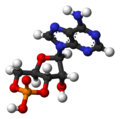Structural Biochemistry/Cell Signaling Pathways/Protein Kinases Signaling Cascades
Overview
[edit | edit source]Protein kinases are not enzymes that can not function by phosphorylating other proteins to assign the proteins a code. The codes instruct the cell to do work, such as divide or grow. Phosphorylation is a common way of activating or inactivating enzymes, and protein kinases are thus often found in signaling pathways. As many as 30% of all human proteins are modified by phosphorylation, making kinases extremely important in cellular regulation. Since one kinase molecule can act on many proteins, the effect of activating a kinase is amplified in the number of target proteins activating. If a kinase acts on another kinase as part of a signaling pathway, the effect of activating the kinase is amplified several times, resulting in a signaling cascade. A cascade can be stopped by removal of phosphate groups by protein phosphatases[1].
An example of a signaling cascade can be seen in life which remodels the extracellular matrix that causes tumor cells to intervene. Heparanase adds onto to the signaling cascade which results in more phosphorylation of specific protein kinases and producing a tumor due to more gene transcription.
Activity
[edit | edit source]Activation
[edit | edit source]Both kinases and phosphatases are regulated by complex signaling pathways. The activation of a kinase at the start of signaling cascade can come from several sources, including cyclic adenosine monophosphate (cAMP) and calmodulin. cAMP release is activated by hormones such as epinephrine.
-
Cyclic adenosine monophosphate
-
Cyclic adenosine monophosphate
-
Calmodulin 3D structure
Example: the binding of cAMP to the regulatory subunit of PKA (protein kinase A) relieves its inhibition of the catalytic subunit. In short, cAMP activates the kinase.
Kinases generally function by bringing an ATP molecule together with the protein to be modified in a hydrophobic pocket to exclude water. A phosphate group is then transferred from ATP to an amino acid on the protein being activated. Phosphorylation usually takes place on the hydroxyl group of serine, threonine, or tyrosine, but there are also kinases that act on other amino acids such as histidine, aspartate, and glutamate. In a signaling cascade, the newly activated protein might also be a kinase that can then phosphorylate other proteins.
The binding of a phosphate group can affect the activity of a protein in two ways. Phosphorylation can directly affect activity by causing a conformational change in the protein. Alternately, the phosphorylated amino acid can be recognized by and bind to specific proteins or other substrates[2]. The carboxyl-terminal includes a phosphotyrosine residue, which can contact with SH2 domain. also, SH2 domain and the Kinase domain is bound by the SH3 domain. in this case the kinase become in its inactive conformation. the protein can be acteivated by three basic steps 1. the phosphotyrosine residue bound in the SH2 pocket, which can be replaced by another phosphotyrosine that containing higher affinity polypeptide for that SH2 domain. 2. in Tyrosine the phosphoryl gp can be removed by a phosphatase and finally 3. the liker can be replaced from SH3 domain by a high affinity polypeptide.
Deactivation
[edit | edit source]Proteins that have been phosphorylated by a protein kinase can be dephosphorylated by protein phosphatases. Phosphatases bring in water to hydrolyze the phosphodiester bond to release the dephosphorylated protein and orthophosphate. The signaling cascade as a whole is stopped when the initial trigger signaling molecules disappear, such as when a hormone is broken down. Some cascades are self terminating, as the activated kinase phosphorylates enzymes that catalyze the breakdown of the trigger molecule, as in the case of cAMP.
Regulation
[edit | edit source]Since kinases can quickly cause very large changes in a cell because of the amplification of a signal, their activity is tightly regulated. Many kinases are themselves controlled by phosphorylation and some kinases phosphorylate themselves, in a process called cis-phosphorylation or autophosporylation. Other means of kinase regulation include the binding of inhibitor or activator proteins or small molecules and controlling their location within the cell.
MAP Kinase
[edit | edit source]Mitogen-Activated Protein Kinase (or MAP kinase) is well known to play an important role in keeping oocytes in an arrested state until fertilization. Scientists believe that MAP kinase signaling is one of very important cellular communication streams. In mammalian eggs, which arrest in metaphase II of meiosis, active MAP kinase keeps the eggs from completing meiosis until after fertilization. Like other protein kinases, it transfers phosphate group from ATP to serine, threonine or tyrosine amino acids on recipient proteins. This phosphorylation will change the activity and function of their target proteins. MAP kinase phosphorylates a variety of cytoplasmic proteins and transcription factors that carry out the downstream effects of the enzyme. MAP kinase is regulated by another protein kinase called MEK which specifically phosphorylates Thr 202 and Tyr 204 in the MAP kinase amino acid chain and turns on the protein kinase activity of MAP kinase. Other functions of MAP kinase include instructing immature cells how to grow up to be specialized cell types or how to die. Since they are keys to many important cell processes, many researchers want to use them as good targets for drugs.
Evidently, MAP kinases activate in response to almost any change in the equilibrium of the environment, and its regulation is very crucial in maintaining the health of the organism. Incorrect MAP kinase signaling can lead to complications such as metabolic syndrome and type 2 diabetes. Metabolic syndrome is the term used to describe various side effects of disruptions in metabolic processes, such as insulin resistance and obesity.
Stress-activated Protein Kinases
[edit | edit source]Stress-activated protein kinase (SAPK) signaling is responsible for regulating cellular responses to environmental changes such as development, transformation, inflammation, and physical stress. SAPK pathways are similar to MAPK pathways due to common characteristics such as substrate specificity and dual phosphorylation. Improper regulation of SAPK signaling may lead to complications such as cardiovascular disease.



